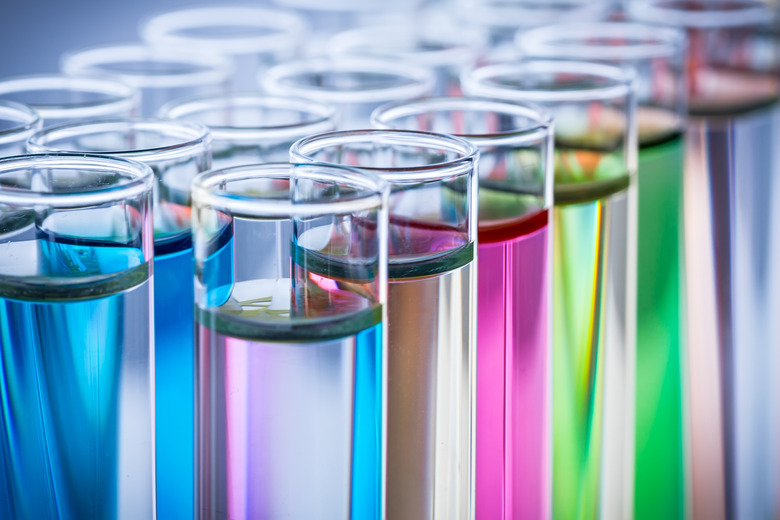Chemical Reactions That Cause Color Change
A chemical reaction isn't always visible to the human eye, but sometimes it results in an impressive color change and makes science experiments more fun to witness. When two or more substances combine, they create one or more new substances, which sometimes have different molecular structures from the original substances, meaning they absorb and radiate light in different ways, leading to a color change.
Sodium Hydroxide and Phenolphthalein
Sodium Hydroxide and Phenolphthalein
Phenolphthalein is a universal indicator, which means it changes color to show the pH of certain solutions. Phenolphthalein stays colorless in acidic solutions and turns pink in alkaline solutions. Sodium hydroxide is a base, so when you add phenolphthalein, the solution turns pink. Other indicators commonly used in the laboratory are litmus and methyl orange. A Litmus indicator solution goes red in acidic solutions, blue in alkaline solutions and purple in neutral solutions. Methyl orange turns red in acidic solutions and yellow in neutral or alkaline solutions.
Starch and Iodine Solutions
Starch and Iodine Solutions
The starch test is a chemical reaction that determines whether starch amylose is present in a substance. When you add starch to iodine in water, it creates a starch/iodine complex with an intense blue color. To test whether starch is present in a foodstuff, mix a solution of iodine and potassium iodide in water. The solution has a light orange-brown color, but when you apply it directly to a sample that contains starch (such as potatoes or bread), it turns a blue-black color.
Hydrated Copper Carbonate
Hydrated Copper Carbonate
When copper reacts with the elements (oxygen, water and carbon dioxide), it turns from its element color of reddish-brown to green. This chemical reaction is hydrated copper carbonate, and a famous example of it is the Statue of Liberty. Built in 1886, the Statue of Liberty was initially reddish-brown. Over time, its copper plates underwent a chemical reaction. The same things can happen to copper pennies. A similar reaction occurs when iron rusts: Iron oxide forms on its surface (oxidation) causing the iron to turn a reddish color.
Blue Bottle Demonstration
Blue Bottle Demonstration
The "blue bottle demonstration" involves a solution of glucose, sodium hydroxide, methylene blue and distilled water. When you shake the solution in a half-filled bottle, oxygen goes into the solution, oxidizing the methylene blue and turning the solution blue. When the shaking stops, the oxygen comes out of the solution, and it goes back to colorless. This is a reversible redox reaction.
Sometimes a change in color is simply the mixing of two colors and not due to a change in the composition of the substances used. For example, putting red food coloring and blue food coloring in a beaker of water results in purple water, but no chemical reaction has occurred. The substances have dissolved in each other but have retained their own molecular identity.
Cite This Article
MLA
Gillespie, Claire. "Chemical Reactions That Cause Color Change" sciencing.com, https://www.sciencing.com/chemical-reactions-cause-color-change-7501675/. 26 April 2018.
APA
Gillespie, Claire. (2018, April 26). Chemical Reactions That Cause Color Change. sciencing.com. Retrieved from https://www.sciencing.com/chemical-reactions-cause-color-change-7501675/
Chicago
Gillespie, Claire. Chemical Reactions That Cause Color Change last modified August 30, 2022. https://www.sciencing.com/chemical-reactions-cause-color-change-7501675/
